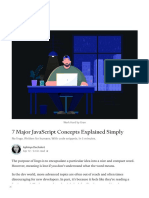0% found this document useful (0 votes)
1 views6 pagesJavaScript Answer
The document provides explanations and outputs for eight JavaScript concepts related to closures, hoisting, destructuring, the event loop, function binding, object properties, class inheritance, and recursive promises. Key takeaways include the differences between 'var' and 'let', the temporal dead zone of 'let', reference mutations during destructuring, the order of execution in the event loop, context loss in function binding, reference comparison in maps, pitfalls in class inheritance, and the dangers of recursive promises. Each concept is illustrated with code examples and their respective outputs.
Uploaded by
nthumarCopyright
© © All Rights Reserved
We take content rights seriously. If you suspect this is your content, claim it here.
Available Formats
Download as PDF, TXT or read online on Scribd
0% found this document useful (0 votes)
1 views6 pagesJavaScript Answer
The document provides explanations and outputs for eight JavaScript concepts related to closures, hoisting, destructuring, the event loop, function binding, object properties, class inheritance, and recursive promises. Key takeaways include the differences between 'var' and 'let', the temporal dead zone of 'let', reference mutations during destructuring, the order of execution in the event loop, context loss in function binding, reference comparison in maps, pitfalls in class inheritance, and the dangers of recursive promises. Each concept is illustrated with code examples and their respective outputs.
Uploaded by
nthumarCopyright
© © All Rights Reserved
We take content rights seriously. If you suspect this is your content, claim it here.
Available Formats
Download as PDF, TXT or read online on Scribd
/ 6





























































































